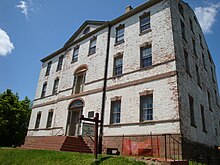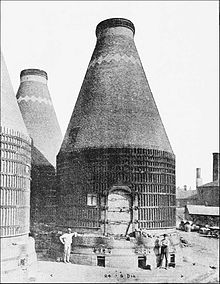Perth Amboy
Perth Amboy is a city located in Middlesex County in the US state of New Jersey. In 2010 it had a population of 50,814 inhabitants and a population density of 3,278 people per km².
History
Name
The Lenape Native Americans called the spot where the city was built "Ompoge", meaning "flat ground" or "standing or upright". When founded in 1684, the new city was called "New Perth" in honor of James Drummond, Earl of Perth, one of 12 partners in a Scottish-owned company; Drummond has been honored with a statue outside City Hall. The Algonquian language name persisted, became corrupted to Ambo, or Point Amboy, and eventually a combination of the native and colonial names emerged, also appearing in South Amboy.
Scottish Colony
Perth Amboy was settled by Scottish settlers around 1683 who had been recruited to inhabit the part of the East Jersey colony owned by Robert Barclay, a Quaker who would later become the province's absentee governor.
Charter and incorporation
Perth Amboy was formed by royal charter on August 4, 1718, from various townships and again by the New Jersey Legislature on December 21, 1784, from within Perth Amboy Township and part of Woodbridge Township. Perth Amboy Township was formed on October 31, 1693, and expanded during the 1720s to encompass the city of Perth Amboy. Perth Amboy Township was incorporated as one of New Jersey's initial 104 townships through the Townships Act of 1798 on February 21, 1798. The township was succeeded by the City of Perth Amboy on April 8, 1844.
Provincial capital
Elizabeth (then known as Elizabethtown) was designated in 1668 as the first capital of New Jersey. In 1686, Perth Amboy was designated as the capital of East Jersey, while Burlington was designated as the capital of West Jersey. After the two were united as a royal colony in 1702, the two cities alternated as the capital of the province of New Jersey until November 1790, when Trenton was designated the capital of the unified state, chosen based on its location. halfway between New York and Philadelphia.
Some of the buildings from this early period still exist. In particular, the Proprietary House, the home of William Franklin, the last royal governor of New Jersey and estranged son of Benjamin Franklin, still stands on the waterfront of the city. Architect John Edward Pryor was hired in 1761 to design and build the building, which was completed in September 1764, years behind schedule and over budget. Franklin preferred his alternate home in Burlington.Franklin finally moved in 1774 to the Proprietary House. Franklin's father, Ben, tried unsuccessfully to convince his son to support the colonial cause. William Franklin was arrested and detained at the Proprietary House in 1776 until he was tried and convicted of treason.
Perth Amboy's City Hall was first built as a courthouse for Middlesex County in 1714, after being designated as the county seat the previous year. The building was later used as the seat of the East Jersey Provincial Assembly. The building was destroyed by a large fire in 1731 and rebuilt in 1745. Another fire was deliberately set in 1764, forcing a rebuild that was completed in 1767. It is the oldest city hall in continuous use in the United States. On November 20, 1789, City Hall was the site of the New Jersey General Assembly meeting to ratify the Bill of Rights, becoming the first state in the nation to do so.
Market Square, located across from City Hall, is a park that had been an open-air market during colonial times. Market Square includes a replica of the Liberty Bell, a statue of George Washington, and the Bill of Rights Arch, commemorating the fact that New Jersey was the first state to ratify the Bill of Rights.
St. Peter's Church, which held its first service in 1685 and received a royal charter in 1718, has been recognized as the state's first Episcopal congregation. Its current building, dating from the 1850s, is surrounded by an early settlers' cemetery and displays a collection of stained glass windows depicting religious scenes, as well as early depictions of New Jersey receiving its letter and a meeting between William Franklin and his father., Ben
Perth Amboy was New Jersey's main port of entry for enslaved Africans.
Kearny Cottage is a surviving example of vernacular architecture from the 18th century. Operated as a historic house museum and operated by the Kearny Cottage Historical Society. Built in 1781 on High Street, the house was moved to Sadowski Parkway in the 1920s and then moved to its current site at 63 Catalpa Avenue, inland from the mouth of the Raritan River.
During the colonial period and for a significant time thereafter, Perth Amboy was a major way station for travelers between New York City and Philadelphia, as it was the site of a ferry that crossed Arthur Kill to Tottenville, Staten Island. The first ferry operated in 1684 and regular service began operating in 1709. This ferry declined in importance when the Outerbridge Crossing opened in 1928, but continued to operate until 1963. In 1998, the Perth Amboy Slip Ferry was restored to its original appearance. from 1904. A replica of the ticket office has been built and is used as a small museum.
On March 31, 1870, Thomas Mundy Peterson became the first African American in the United States to vote in an election under the newly enacted provisions of the Fifteenth Amendment to the United States Constitution. Peterson voted in an election to update the Perth Amboy city charter.
Industrialization and Immigration
In the mid-19th century, immigration and industrialization transformed Perth Amboy. Factories such as A. Hall and Sons Terra Cotta, Guggenheim and Sons, and the Copper Works Smelting Company fueled a thriving downtown area and employed many area residents. Growth was further spurred by becoming the tidal water terminal for the Lehigh Valley Railroad and a shipping point for coal. Perth Amboy developed close-knit, insular ethnic neighborhoods such as Budapest, Dublin, and Chickentown. Immigrants from Denmark, Poland, Hungary, Czechoslovakia, Italy, Russia and Austria quickly dominated factory jobs.
In 1903, the Perth Amboy Public Library, one of the first Carnegie libraries in the state, was made possible by grants from Andrew Carnegie and donations from local philanthropists, and opened to the public.
In 1914, Perth Amboy was home to a minor league baseball team called the Perth Amboy Pacers, which played as a member of the Class D-level Atlantic League. After one season, this league was closed.
In late August 1923, approximately 6,000 people rioted, breaking through police lines after the Ku Klux Klan tried to stage a rally in the city.
The city was a resort town in the 19th century and early XX, located at the northern end of Raritan Bayshore. Since the early 1990s, Perth Amboy has undergone a redevelopment. Small businesses have begun to open up, helped by the city's designation as an Urban Business Zone. The boardwalk has also seen a renaissance. The marina has been expanded and there are new promenades, parks and houses overlooking the bay.
The chapter "More alarms at night" from humorist James Thurber's biography My Life and Hard Times involves Perth Amboy. One night as a teenager in Ohio, young Thurber can't sleep because he can't remember the name of this New Jersey community. He wakes up his father and demands that she start naming towns in New Jersey. When the surprised father names several towns with one-word names, Thurber replies that the name he's looking for is "two words, sort of random." This convinces his father that Thurber has gone dangerously insane. Thurber also wrote the story that was later made into the film The Secret Life of Walter Mitty, about an "inconsequential boy from Perth Amboy, New Jersey". Perth Amboy water is located in Old Bridge Township.
Geography
Perth Amboy is located at the coordinates 40°31′10″N 74°16′31″W / 40.51944, -74.27528.
Demographics
According to the Census Bureau in 2000 the median household income in the town was $37,608 and the median family income was $40,740. Men had a median income of $29,399 versus $21,954 for women. The per capita income for the town was $14,989. About 17.6% of the population was below the poverty line.
Contenido relacionado
Territorial organization of Namibia
Historical center of lima
Quirós

